My phone camera doesn’t quite capture the view I take in with my own eyes– the glass-like aqua blue water, the sweeping mountains lined with pine trees trailing all the way down to shore, the boulders bigger than cars that rest partially submerged– but looking back at my photos, I’m reminded of the fond memories I made here. The past month of my life revolving around Lake Tahoe was truly something spectacular, and I know I’ll be back someday to enjoy the beautiful scenery once again.
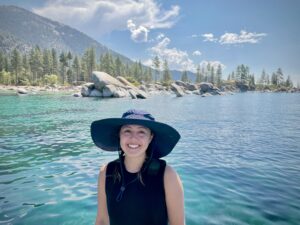
Sand Harbor, Lake Tahoe. Photo credit: Brant Allen
The second leg of my internship was based at the UC Davis Tahoe Environmental Research Center (TERC), located in Incline Village, Nevada. I arrived a week before field work began but jumped right into the action as I was settling in. There was quite a bit of preparation to be done for the underwater surveys that I would be helping with. The Asian clam, a non-native species to Lake Tahoe, was first reported by TERC researchers in the south-eastern shore of the lake back in 2002, likely from an accidental introduction from a visiting boat. Since then, they have been spotted in other areas of the lake, including Sand Harbor. The main concern for their appearance in the lake is the algae that follows them. In densely populated areas of clams, this green algae builds up along the bottom due to the nutrients released by these shellfish. Large plumes grow, cloud up the water, and eventually end up washing up to shore. Lake Tahoe is known for its picturesque, clear blue water and scenic shorelines, but the Asian clam may soon alter these idyllic features if left unchecked. And this was why I was jumping in.
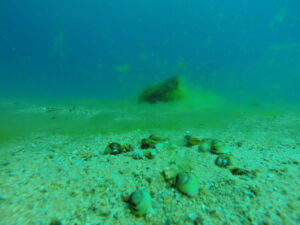
Invasive Asian clams (Corbicula fluminea) blanketed by green algae. Photo credit: Brandon Berry
My task was to help capture underwater data with the TERC Dive Field Team as part of a multi-year clam-population study at Sand Harbor, located on the eastern shore of the lake. One of the team members, Erik Young, was a fellow AAUS scientific diving trainee with me at Bodega Marine Lab (BML) earlier this summer. The other three members– Katie Senft, Brandon Berry, and Brant Allen– were seasoned clam-collectors and showed me and Erik the ropes for the study. For two weeks, we got up early to hop on the R/V Bob Richards at the Tahoe City Marina and travel across the lake. Some of our survey sites were shallow enough to snorkel along, but the deepest areas we surveyed were at about 35 feet. We slipped into our wetsuits, staged our gear, and stepped off the boat with our minnow traps, which we used to scoop up the sand and filter out for clams.
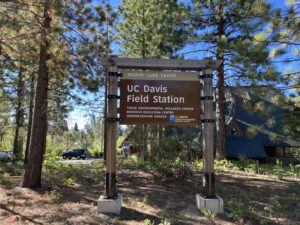
My mornings began at the field station in Tahoe City. Photo credit: Yuen Azu
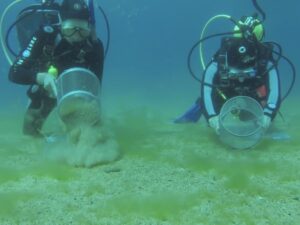
Katie Senft (left) and me (right) collecting clams with our minnow traps. Photo credit: Brandon Berry
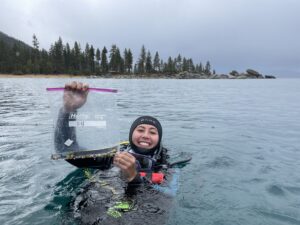
Holding up a bag of clams. Photo credit: Katie Senft
The first week was the perfect temperature for our dives. It was hot enough at the surface for us to stay comfortably warm underwater for over half an hour. However, a fire was burning southwest of Lake Tahoe and was carrying over smoke and colder temperatures. On top of this, I had unfortunately caught swimmer’s ear and had to take a couple of days off to heal up. It was agonizing to miss out, but I was able to rejoin the group for the last few days and finish our mission.
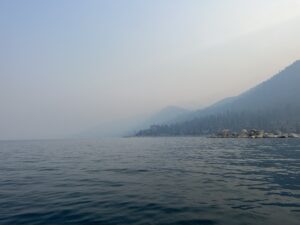
A smoked-out view of the lake from the Mosquito Fire. Photo credit: Yuen Azu
My research dives at the lake had concluded, but the clam survey was far from over. It was now time to count and measure every single clam that we had collected. Dressed in a lab coat with calipers in hand, I went through jars and jars of our preserved bivalves and took careful notes of their measurements. The raw data sheets had to be transferred to the computer, so when I got tired of measuring I switched over to data entry. With the help of the others, we were able to get through most of the samples in four days, before my time at TERC was up.
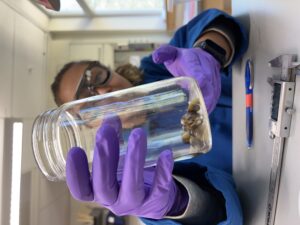
Measuring clams back at the TERC laboratory. Photo credit: Yuen Azu
The last official week of my internship was spent learning how to dive with a drysuit. Emerald Bay, the southern region of Lake Tahoe, was my training ground. The State Parks Dive Team had generously included UC Davis divers for their refresher course on underwater surveying, and Jason Herum, my instructor and main BML contact, was in charge of teaching the Altitude Diving course. Over three days, we learned about the precautions needed to dive over 1000 feet above sea level and I went on six drysuit dives.
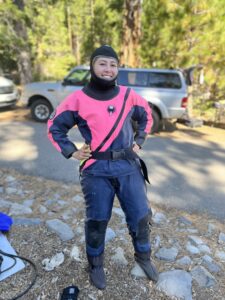
Donned in a drysuit for the first time. Photo credit: Sydney Salley
Drysuits, as opposed to wetsuits, are water-proof and require air from your tank to be added as you dive. With the added complications of an extra air space, you’ll need to be trained and certified to use one. It was strange to have to return to buoyancy-control basics, a skill that had become natural to me over the years. As I waded into the water in my hot-pink rental for the first time, I pressed the inflator valve on my chest to add some air inside the water-proof suit. The deflator valve was located just below my left shoulder, and I had opened it almost all the way to allow air to vent out whenever I lifted my arm. Jason and I swam not too far from shore and descended to the sandy bottom at about 10 feet. I practiced adding enough air to my suit to hover above the bottom, then letting out the air so we could kneel. I lifted my left elbow up gently and a string of bubbles escaped out of the deflator valve – Jason called the motion ‘the chicken-wing’. Next, we practiced a technique to right yourself if the air moves to your feet and causes you to go upside-down. After moving into a head-first position, Jason tucked in his upper-half and rolled forward into an upright position. I copied, with mild success. After practicing the new drills in the shallows for a while, we headed down the steep slope further off-shore so I could work on adjusting the air in my suit as we descended. It was the first time I felt the thermocline– a depth in the water column that was much colder than above– while diving in Tahoe.
For the next few days, I dove alongside my friends and instructors from BML, exploring several old wrecks and continuing to hone my buoyancy. The morning of our last dive, Jason gave me and the other two drysuit trainees a new task: we were to lead the dives as a trio. Up until that point, we had been following Jason underwater. We floated at the surface for a few minutes to hash out a plan and then descended. Once we were on our way however, we realized our discussion was not detailed enough. We hadn’t picked out an actual lead among the three of us, nor had we decided how long we were staying in the shallower area to review our drysuit skills before descending further for the rest of our dive. With the limitations of hand signals to communicate, we struggled to coordinate. Immediately after surfacing we debriefed on the issues we had. Our second and final dive that day was to redeem ourselves, and this time, we were much more explicit and careful with our dive plan. It was a serene dive as we descended upon a sunken boat not too far from shore. We had all vastly improved on our buoyancy control and seamlessly executed our plan. As I surfaced this time, I was elated that it went so well, but it was dawning on me that it was my last internship dive. My final day in Lake Tahoe had proved to be an important lesson on dive planning, and so I finished my internship with a drysuit certificate and a healthy dose of humility.
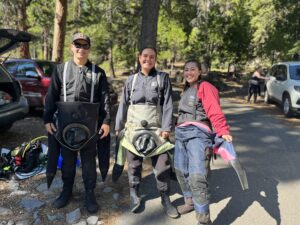
My fellow dive-mates Erik Young (left) and Sydney Salley (middle) getting into our drysuits. Photo credit: John Harreld
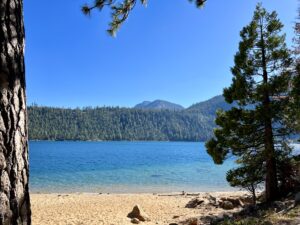
Emerald Bay dive site. Photo credit: Yuen Azu
Although my time as the OWUSS/AAUS Dr. Lee. H. Somers Intern has come to an end, it has opened up a world of opportunities that I am excited to explore next. With just a semester left of my undergraduate education, I am hoping to find a research position that involves lots of diving within the next year. From there, I’ll gain more experience to prepare me for graduate school and a career in marine biological research. There were so many people that I met these past few months that impacted my experience, not just those explicitly mentioned in my blog. To all those whom I learned from, learned with, and/or shared any of the incredible experiences I had, I am deeply grateful that our paths crossed.
I also cannot go without saying thank you to my wonderful family on the west coast who all made me feel right at home, and to my friends and immediate family for their support. My deepest gratitude goes towards The AAUS Foundation, which made this internship possible in conjunction with the Our World Underwater Scholarship Society. Finally, I have to thank my OWUSS family and my hosts at UC Davis for making sure my internship was a blast!

